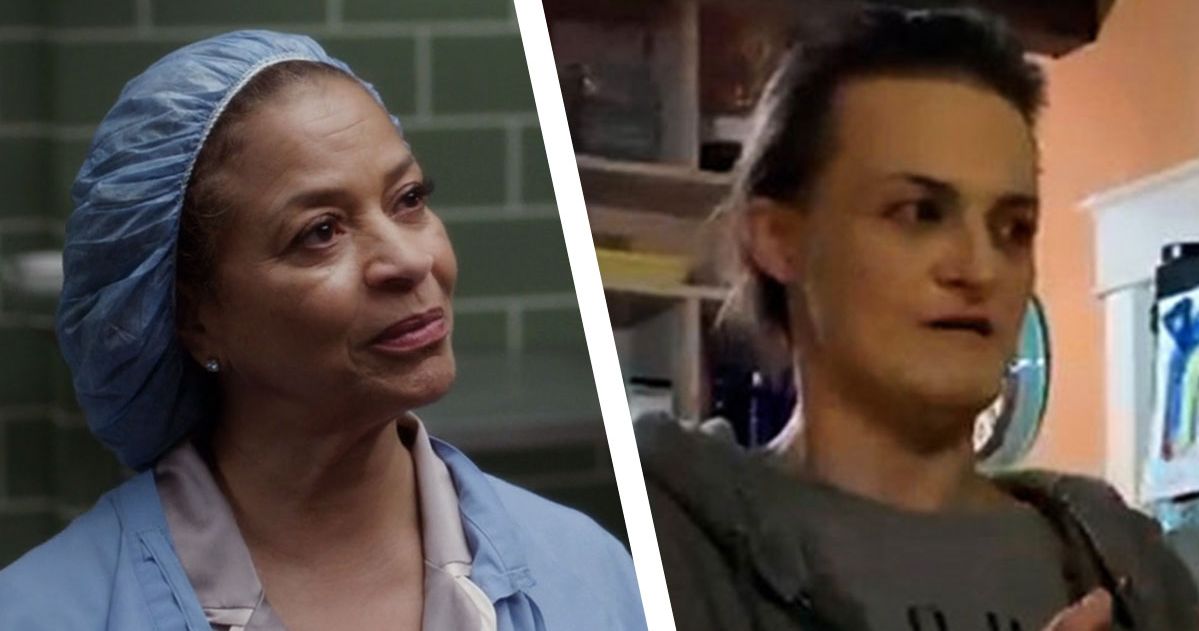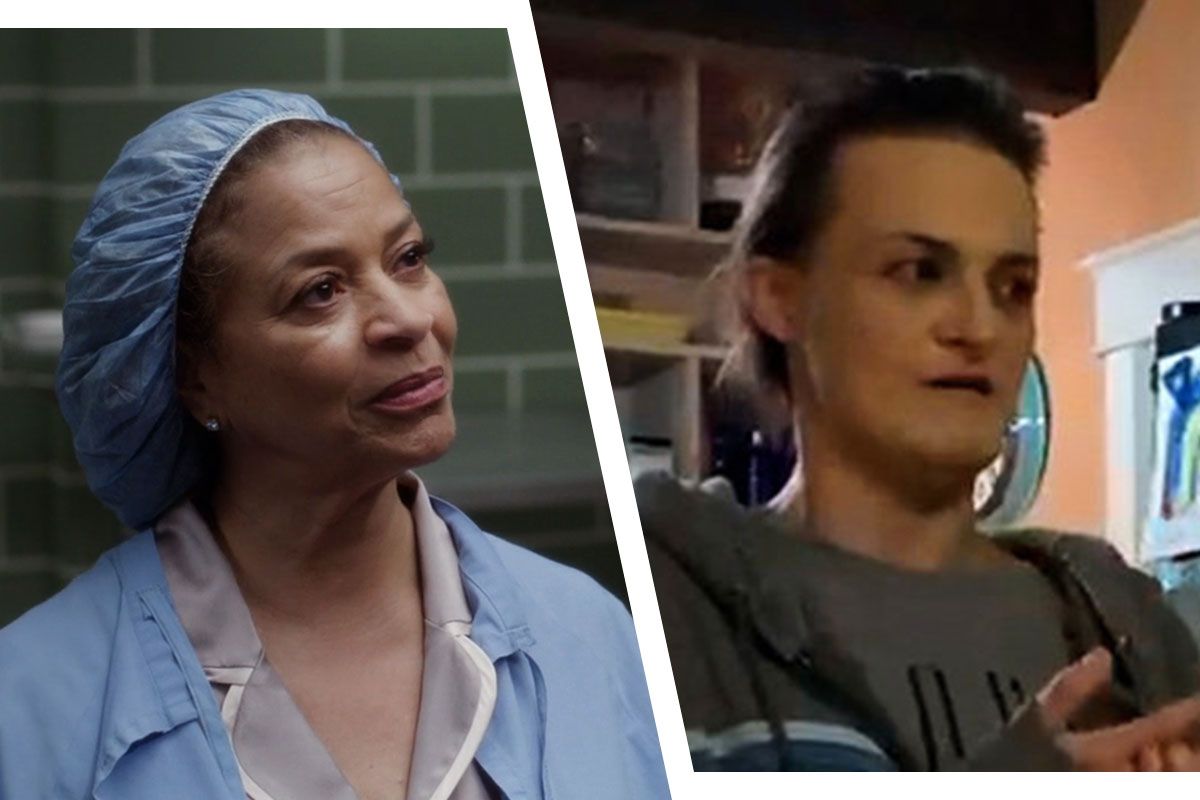Anatomy of Lies Dissects Elisabeth Finch’s Grey’s Fabrications
The disgraced TV writer didn’t just blur the line between fiction and reality, she obliterated it.


Grey’s Anatomy has always reveled in big narrative swings and surprising twists, which is one of the reasons it has stayed on the air for 21 seasons and counting. While the ABC series certainly succumbs to certain tropes of the medical drama, it also prides itself on its ability to knock the wind out of viewers with developments they can’t possibly see coming, be it the sudden death of Dr. Derek Shepherd or that patient in season seven whose body was overrun with so many HPV warts that he looked like Groot. The more unexpected the plot point, the better for Grey’s Anatomy.
No one got that on a more personal, extreme level than Elisabeth Finch, a former writer and executive producer for Grey’s Anatomy who told so many untruths that eroded the line between her personal and professional lives that she basically created her own ecosystem of deceit. Finch was hired on Grey’s Anatomy in 2014 and received writing credits on 13 episodes over seven seasons before leaving the show in 2021, not long after her bosses were tipped off that she had been deceiving them on multiple, disturbing fronts during her entire time on staff.
The new Peacock docuseries Anatomy of Lies, directed by Evgenia Peretz and David Schisgall and based on Peretz’s 2022 Vanity Fair article “Scene Stealer,” recounts the details of all that deceit and how Finch’s lies boosted her rise from lower-level TV writer/essayist to one of the most revered writers and EPs on Grey’s. Almost every falsehood she spread — particularly her totally not real bone cancer and the PTSD she claimed to suffer following the equally nonexistent death of a friend in the attack at the Tree of Life synagogue — wove its way into a story line on Grey’s Anatomy or bolstered her reputation within the industry, often at the expense of colleagues, friends, and loved ones, particularly the woman who became her wife, Jennifer Beyer. When Finch wasn’t concocting details on her own, she often liberally borrowed them from other people’s lives without their consent.
“I think she probably saw her life as a TV series,” posits Matt Graham, a British writer and former USC film-school classmate of Finch’s, in the docuseries. “Season one: I’ve got cancer. Season two: It’s gotten worse. Season three: The lie keeps getting bigger. The story keeps getting bigger because that’s how you keep your audience.”
Finch clearly understood how to keep the interest of an audience, both on television and within her own personal orbit. Her most appalling transgressions, all covered in Anatomy of Lies, illustrate how thoroughly she erased the line between TV and reality.
1. Finch lied, over the course of multiple years, about having cancer, then made the disease a plot point. Prior to working at Grey’s, Finch, who had previously written for True Blood and The Vampire Diaries, penned a personal essay for Elle magazine about her struggle with chondrosarcoma, an aggressive form of bone cancer. The part she left out? She didn’t actually have chondrosarcoma.
The essay caught the attention of Grey’s Anatomy creator Shonda Rhimes, who hired Finch in 2014. According to former Grey’s writer Kiley Donovan, when Finch was “on the chopping block” because some people on the show weren’t happy with what she had produced, the “leadership” made sure she stayed on staff, in part because they didn’t want to fire someone with cancer. (The documentary does not say whether leadership includes Rhimes, but that’s a reasonable assumption.) A horrible disease was both Finch’s way onto the staff and a guarantee that she would stay there.
As Anatomy of Lies recounts, Finch went to wild lengths to keep the ruse alive, shaving her head, taking puke breaks during the workday, and even sporting a fake port on her chest that would sometimes peek out when she was wearing tops with a wide neck. No one suspected anything was off, not even friends like Aurora Lee Passin, who transported her to treatments when she was supposedly enrolled in a clinical trial at the Mayo Clinic.
“She would tell me, ‘Maybe I’m suffering this way so that I can write this way, too,’” Passin tells the filmmakers. In season 15 of Grey’s, Finch did just that, having Debbie Allen’s Dr. Catherine Fox get diagnosed with chondrosarcoma. The episode in which she receives the initial diagnosis, “The Winner Takes It All,” generated some press for Finch because of the overlap with her “real life.” If, as Graham says, one’s personal story is “the most important commodity one possesses,” Finch created one she could leverage in her writing and for clout. It worked beautifully. For a while.
2. She stole another writer’s story and put it into a different season-15 episode. In the 2019 episode “Silent All These Years,” Jo (Camilla Luddington), a character for whom Finch frequently wrote, finds out from her mother that she was born from rape. In a title card that appears at the end of each episode, Anatomy of Lies notes that Finch said she was inspired to write the episode by the Brett Kavanaugh hearings, while Luddington, who declined to be interviewed, said she suggested the idea for the same reason. But Donovan believes that Finch blatantly borrowed the plot point from her. The writer says in the doc she once confided in Finch that she had recently learned that her mother gave birth to her after being raped, and was later surprised to see it pop up in one of Finch’s episodes. Finch never acknowledged the connection. According to Donovan, Finch was privately called a “trauma vampire” because of behavior like this.
3. She checked into a treatment center in Tucson under a Grey’s-related assumed name. Finch publicly mourned the loss of a friend who died in the 2018 attack on the Tree of Life synagogue in Pittsburgh, which she attended occasionally during her college years. After posting on social media that she had actually gone to Pittsburgh and spent all day cleaning up her friend’s remains, she later said the incident had given her PTSD and told her Grey’s colleagues that she had entered a facility in Arizona so she could get well. Unbeknownst to them at the time, she checked in under a pseudonym: Jo, the same name as Luddington’s Grey’s Anatomy character. On the show, Jo would check into a treatment center toward the end of season 15 with the hope of figuring out how to cope with learning her birth father raped her mother. The documentary says the treatment-center story line was Finch’s idea.
The foundation for all of this fiction evolved from one of Finch’s most appalling fibs: that she had actually lost someone in the mass shooting at the Pittsburgh synagogue. She hadn’t. In fact, as her wife would eventually discover, she hadn’t gone to Pittsburgh at all during that time period; pictures on Facebook dated October 27, 2018, show her at a bar celebrating Halloween with friends. She appears to be dressed as Wednesday Addams.
4. She inserted her wife’s EMDR treatment into a season-16 episode. While at the facility in Tucson, Finch met Beyer, who was being treated in the wake of a dissociative episode brought on by severe abuse at the hands of her husband, Brendan. The episode led to her five children being taken away from her and placed in foster care. In short: She was not in a good place when Finch befriended her, and Finch ingratiating her way into this traumatized family is one of the most heartless maneuvers we see her pull in Anatomy of Lies.
But initially, Finch’s interest in and care for Beyer, as well as her children, seemed genuine; as Beyer says at one point, when you’re in love, it’s very easy to ignore red flags. The fact that Beyer received EMDR treatment, a sensory-based therapy designed to help patients heal from traumatic incidents, and that Finch later inserted EMDR treatment into one of Jo’s story lines, should have been one of those red flags.
5. She lied unrepentantly about her brother’s death and borrowed a Grey’s Anatomy plot point to do it. According to Anatomy of Lies, when Beyer learned that her ex-husband Brendan had taken his own life, she and Finch immediately rushed from L.A. back to Topeka, Kansas, where Beyer and her children lived, to deal with the tragedy. But Finch didn’t explain that to her colleagues. Instead, she sent an email to the Grey’s staff saying that her brother was in a coma after an attempt to take his own life. Compounding the drama further — because, remember, the story has to keep getting bigger — Finch said her sibling, a doctor, attempted to kill himself in a way that would guarantee he didn’t immediately die, putting the responsibility for pulling the plug in his sister’s hands.
If this sounds like something that happened on Grey’s Anatomy, that’s because it kind of did. In a season-four episode, while in therapy, Meredith Grey (Ellen Pompeo) realizes her mother’s suicide attempt years ago wasn’t as serious as she thought because Ellis Grey, a skilled surgeon, knew exactly how to harm herself without causing permanent damage. At the time that Finch shared what had happened with her brother, who she also alleged abused her in childhood, no one on the staff made that connection. Once again, Finch had fabricated a story that painted herself as both a victim and a selfless hero tending to the brother that mistreated her — as the documentary notes, there is no evidence this actually occurred — while simultaneously co-opting someone else’s pain.
“I was like, Oh my God, she turned Eric into Brendan,” Beyer says of realizing later what Finch had written. Finch’s brother, by the way, is still very much alive and practicing medicine in Florida, according to the series.
6. She wrote Alex Karev’s farewell with an homage to her personal life. Season 16’s “Leave a Light On” functioned as a send-off for Justin Chambers’s character, Alex Karev, a mainstay on the series who very abruptly disappeared several episodes prior with no explanation of what happened to his character. Finch wrote the episode that explains why Alex abruptly left Seattle. The answer: to move to a farm in Topeka and reconcile with Katherine Heigl’s Izzie, with whom he recently discovered he has children. That reveal mirrors one that surprised some members of the team at Grey’s: that Finch had gotten engaged to Beyer in November of 2019 and planned to move to Topeka, where she would continue to write for the series remotely, to help raise Beyer’s five children. Even though Alex had bailed on everyone he knew, including his wife, Jo, his decision is depicted in the episode as understandable, almost as if Finch is patting herself on the back for being with Beyer and her kids, even though that relationship would eventually blow up once Beyer realized the extent of Finch’s rampant dishonesty.
Satisfying or not, “Leave a Light On” does at least provide answers, something Anatomy of Lies is unable to do. Finch declined to be interviewed for the documentary. So did her brother (understandably) and her parents (also understandably). Though Peretz and Schisgall mention an Ankler interview from 2022 that Finch participated in, the closest she’s come to offering a postmortem on this whole debacle, we never get to hear from her directly. While her former co-workers suggest she’s still trying to return to the industry, the docuseries never adequately explains why Finch spread so much hurtful disinformation. “Some mysteries will never be solved. Some people will never be known,” says former Grey’s writer Andy Reaser near the end of the third and final episode.
Which: sure. But on a broadcast drama like Grey’s Anatomy, people need something more than unhinged plot twists. They need closure, which is ironically the thing that Elisabeth Finch hasn’t been able to give the audience. Late on Tuesday afternoon, the day Anatomy of Lies dropped on Peacock, she posted a long apology note on Instagram expressing remorse over what she did. But she still has not adequately explained her behavior. That’s the one thing a TV show can do that — so far, anyway — Elisabeth Finch can’t: provide the context that makes everything she did make sense.








